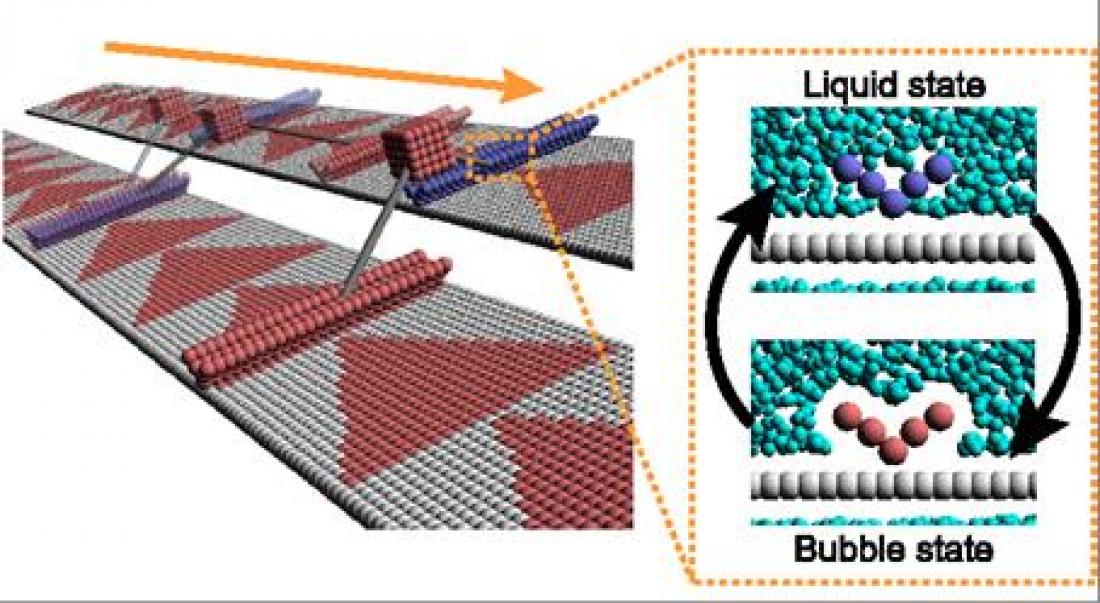Molecular motors: Bubble-driven walking: A computer simulation of the motor-rail system. The walking mechanism is explained by the alternation between the bubble and the liquid state.
Feature
An 'optical comb' for medicine, environment, astronomy, and other applications
http://www.ru.uec.ac.jp/e-bulletin/
Kaoru Minoshima
Research Director of the 'JST-ERATO MINOSHIMA Intelligent Optical Synthesizer Project'
Applications of 'optical frequency combs’ include metrology, such as an optical ruler, optical atomic clocks, imaging, astronomy and spectroscopy.
Research Highlights
Bioimaging: Visualizing real-time development of capillary networks in adult brains
http://www.ru.uec.ac.jp/e-bulletin/research-highlights/2014/visualizing-...
Kazuto Masamoto and co-workers at the University of Electro-Communications in Tokyo, National Institute of Radiological Sciences, and Keio University School of Medicine, have used 4D live imaging technology to study the effects of hypoxia (a deprivation of oxygen) on the BBB plasticity in live adult mice.
Fusion Science: Heavy ions and lost resonance lines
http://www.ru.uec.ac.jp/e-bulletin/research-highlights/2014/heavy-ions-a...
Identifying the ns-np resonance lines in alkali-metal-like ions is an important issue in fusion plasma science in the view of spectroscopic diagnostics and radiation power loss. Whereas for n = 2, 3 and 4 these resonances are prominent and well studied, so far no one could clearly identify the resonance lines for n = 5, the so-called promethiumlike sequence.
Nobuyuki Nakamura at the Institute of Laser Science of the University of Electro-Communications in Tokyo, and colleagues at the National Institute for Fusion Science and SOKENDAI have now experimentally clarified the reason for the lost resonance lines.
Molecular motors: Bubble-driven walking
http://www.ru.uec.ac.jp/e-bulletin/research-highlights/2014/bubble-drive...
Computer simulations of relatively simple models provide clues to the complex physical mechanisms at work in real biomolecule motors.
A collaboration including the University of Electro-Communications, Keio University, RIKEN, University of Fukui and University of Nebraska-Lincoln led by Noriyoshi Arai previously suggested that the transition between the two states is caused by bubble formation. Arai and co-workers have now refined their model including a more realistic temperature-controlled switching mechanism.
Data security: Unexpected information leakage from side channel
http://www.ru.uec.ac.jp/e-bulletin/research-highlights/2014/unexpected-i...
In this high-technology age, finding ways to prevent information leakage via device hacking is increasingly important. In order to pre-empt attacks, researchers carry out false attacks on encrypted devices to find weaknesses that may be exploited in order to implement safeguards.
Kazuo Sakiyama and his group at the University of Electro-Communications in Tokyo has uncovered a previously unknown target they refer to as 'fault sensitivity' that can be exploited in devices to retrieve sensitive data such as secret information (cryptographic key). The target lies on the threshold between a device's normal behaviour and any abnormal behaviour triggered when a device is attacked.
Further information:
International Public Relations
The University of Electro-Communications
1-5-1 Chofugaoka, Chofu, Tokyo 182-8585
E-mail: [email protected]
Website: http://www.uec.ac.jp/
About The University of Electro-Communications
The University of Electro-Communications (UEC) in Tokyo is a small, luminous university at the forefront of applied sciences, engineering, and technology research. Its roots go back to the Technical
Institute for Wireless Commutations, which was established in 1918 by the Wireless Association to train so-called wireless engineers in maritime communications in response to the Titanic disaster in 1912. In 1949, the UEC was established as a national university by the Japanese Ministry of Education, and moved in 1957 from Meguro to its current Chofu campus Tokyo.
With approximately 4,000 students and 350 faculty, UEC is regarded as a small university, but with particular expertise in wireless communications, laser science, robotics, informatics, and material science, to name just a few areas of research.
The UEC was selected for the Ministry of Education, Culture, Sports, Science and Technology (MEXT) Program for Promoting the Enhancement of Research Universities as a result of its strengths in three main areas: optics and photonics research, where we are number one for the number of joint publications with foreign researchers; wireless communications, which reflects our roots; and materials-based research, particularly on fuel cells.
Website: http://www.uec.ac.jp/



